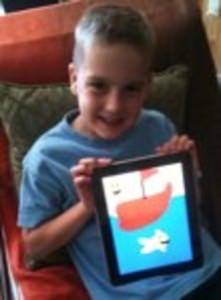Yesterday, we posted part one of the findings for “Children’s Future Requests for Computers and the Internet” (PDF summary), an open innovation study by Latitude Research and ReadWriteWeb. The study asked children aged 12 and under to illustrate their ideas for new Web and computer technologies.

In our previous post, we looked at the findings from an interaction angle. We discussed how younger generations expect to have increasingly intuitive interactions with technology – and not just localized to swiping and tapping an iPad, but really moving things in the world of physical activity and objects. This represents “a shift from smartphones that can go anywhere to The Internet of Things which is everywhere,” said Jessica Reinis, the analyst who headed up the study.
Kim Gaskins is Director of Content Development at Latitude, an international research consultancy. Visit life-connected.com for other studies in Latitude’s open innovation series.
Today’s post will focus on a few other themes that stood out in the kids’ “future requests” for technology and why we think they’re worth acknowledging.
Confidence Through Creation and Creativity

Study participant, Dylan, age 6, killing time on his visit to Latitude HQ.
Download a PDF of the study summary. Part one of this series was published on July 7.
It’s no surprise that gaming is popular with kids. But creation and design? Yep – unsung favorites. Thirty one percent of technology ideas proposed by children were a tool or platform for creating something (a Web site, a game, a video to be shared, a physical object, etc.).
“Artistic creation and design were common underlying principles for a large subset of the kids’ technology concepts, with truly incredible diversity across disciplines. Kids wanted to be 3D game designers, Web designers, fashion designers, landscape designers, industrial designers, musicians, ‘traditional’ artists – and then, of course, the study itself was an exercise in imaginative creation,” said Reinis.

“I’d like to paint and draw right on the computer screen and have it show up.” – Abby*, Age 8

“I’d like to make up my own video game.” – Zack, Age 8

“I’d like computer games to learn about fashion designing.” – Klara, Age 11
Per usual, MIT’s Media Lab is doing great things. This time, it’s providing the tech infrastructure to help kids create. It devised a simple language called Scratch that kids aged 8 and older can use to make interactive animations, annotated stories, games, music and art. Through an external sensor kit, media created using Scratch can interact with everyday objects such as pencils or water.
This study suggests there’s more opportunities to build and extend environments like Scratch (especially ones that are conversant with the physical world) as children’s offerings. (And, of course, when given these types of generative tools for ideation purposes, kids can contribute real value to innovation processes.)
Interestingly, kids’ drive to create – and the expectation that technology will assist creative expression – was highly under-acknowledged by parents. When we asked participants’ parents outright what their children’s favorite computer activities were, only 7% chose some form of creation or design as an option while, not surprisingly, 70% selected gaming. By contrast, children’s own inventions revealed artistic design as a close second to gaming.

Selection of themes coded in children’s drawings (n=126)
The Social World is Growing – and Shrinking?
Social networking was especially popular amongst 10- to 12-year-olds, who contributed 56% of all socially-enabling innovations. What’s more, some participants expressed a desire to expand their social spheres beyond family and friends; they wanted to meet children in far-distant locales (e.g. remotely through immersive “chat” environments).

“I want to video kids on the other side of the world using a different kind of language.” – Emma, Age 7
“Continuous connectivity to people and information via the Web is the norm for many kids today, and it seems to be making them feel more capable and independent – making life opportunities feel closer at hand,” said Reinis. They can look up any piece of information on Wikipedia in real-time, they can self-learn with sophisticated, interactive games, and they can even video chat international language partners on Skype for free – and many of them want to do these things.
“We see this drive to experience the world at large and the drive to express oneself in it as symptoms of a much larger phenomenon – a special brand of confidence – which we’re calling ‘digital optimism’,” she continued. For kids today, the world, ironically, feels smaller and more accessible – just as their awareness of its size, diversity, and possibility is increasing.
*The names of some of the children have been changed to protect the participants’ privacy. In select cases, participant drawings may be modified solely for the purposes of removing identifying information (e.g. the participant’s name).
Latitude is an international research consultancy exploring how new information and communications technologies can enhance human experiences. Latitude’s user-centered research approach unites generative, media-based methods with robust quantitative analysis to identify concrete opportunities for Web-based innovation. “Children’s ‘Future Requests’ for Computers and the Internet” is one installment of Latitude 42s, an ongoing series of open innovation research studies which Latitude publishes in the spirit of knowledge-sharing and opportunity discovery. For more information on this study and its applications to your business, email Neela Sakaria.










